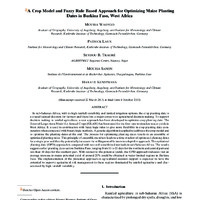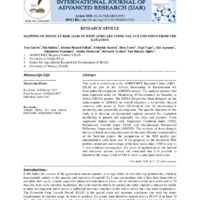Recherche
11 items
A Crop Model and Fuzzy Rule Based Approach for Optimizing Maize Planting Dates in Burkina Faso, West Africa
In sub-Saharan Africa, with its high rainfall variability and limited irrigation options, the crop planting date is a crucial tactical decision for farmers and therefore a major concern in agricultural decision making.
Ensuring peaceful livestock mobility
Mobile livestock production in the Sahel and West Africa is a way of life and a form of adaptation and resilience developed over thousands of years by pastoralists and agro-pastoralists to cope with the effects of desertification and climate change, and to make the best use of the vast expanses of arid and semi-arid regions. This livestock farming system makes it possible to seek complementarities with the agro-ecological zones of the southern savannah regions through the use of pasture and water. In this way, livestock farming helps to provide substantial income for the local population and ensure food security. The N’Djamena symposium in the Republic of Chad (May 2013) and the Nouakchott declaration in the Islamic Republic of Mauritania (October 2013) gave renewed interest to the livestock sector with the implementation of several regional initiatives such as PRAPS, PREDIP, PEPISAO financed respectively by the World Bank, the European Union and the Agence Française de Développement and coordinated by CILSS as well as others such as PACBAO, MOPSS, etc.
Expanding capacity for translating seasonal climate forecasts into actionable information for agriculture and water sectors in West Africa: Lessons learnt and way forward
With climate change and variability posing challenges to sub-Saharan Africa’s development sectors, weather and climate information services are crucial for building climate-resilient development pathways (Hansen et al., 2022). Seasonal forecasts in particular provide prospective information about the upcoming season, with a particular focus on precipitation and temperature (Guido et al., 2020; Hansen et al., 2011). However, a direct and linear translation of the seasonal forecasts to sector-specific information such as water resources and agriculture can lead to inaccurate recommendations. Integrating seasonal forecast data into biophysical models can enable the generation of sector-relevant actionable information that can improve the decision-making (Hansen, 2005; Houngnibo et al 2023). This would contribute to a better understanding of the impacts of climate forecasts in the water and agriculture sectors, among others, thereby facilitating more informed decision-making.
Regional operational meteorological centers, including AGRHYMET Regional Climate Center for West Africa and the Sahel (AGRHYMET CCR-AOS), are regularly producing seasonal climate forecasts to help inform adaptation decision-making at various levels. As a Regional Climate Center, AGRHYMET CCR-AOS coordinates the development of consensus seasonal forecasts through Regional Climate Outlook Forums (RCOF), which bring together experts from National Meteorological and Hydrological Services (NMHSs), basin organizations, and global climate centers. AGRHYMET CCR-AOS has proposed a new approach to translate seasonal forecasts into sector-specific actionable information for agriculture and water sectors through crop and hydrological models. This is referred to as extended seasonal forecasts in agriculture and water sectors (Houngnibo et al 2023).
As part of AICCRA West Africa cluster activities, AGRHYMET has capacitated NMHSs in West Africa and the Sahel on this approach as a first step towards extended and widespread uptake and utilisation in NMHSs in the region. The capacity building event took place in Ouagadougou, Burkina-Faso from August 7th to 11th, 2023. The objective was to enhance the capacity of NMHSs to use new tools that combine seasonal forecasts with impact models in the agriculture and water resources sectors. This Info Note documents the process, key insights and lessons from the regional capacity building for translating seasonal forecasts into actionable information for agriculture and water sectors in West Africa for a better-informed policy and action decision making.
Improving Weather Forecasts in West Africa Using WRF Model
The lack of weather and climate information at appropriate scales is one of the major obstacles to disaster risk reduction in West Africa. The AGRHYMET Regional Climate Center for West Africa and its partners have undertaken to implement projects aimed at filling these gaps. It has equipped itself with the technical infrastructure and established the necessary expertise to produce Numerical Weather Prediction (NWP) with the Weather Research and Forecasting Model (WRF) model to provide NMHSs with information and tailored products for their operational activities. Since 2021, AGRHYMET has been equipped with a high-performance computing facility and has started implementing the WRF model to make short and medium-range forecasts. Thus, there is a need to assess the accuracy of the outputs that have been obtained so far to facilitate the improvement of the whole WRF modeling process at AGRHYMET. In this info note, we have explored the methodology used to assess WRF outputs at AGRHYMET and presented some preliminary results.
Mapping of Zones At Risk (ZAR) in west Africa by using NGI, VCI and SNDVI from the E-statuib
This work is carried out at the AGRHYMET Regional Centre (ARC)-CILSS as part of the African Monitoring of Environment for Sustainable Development (AMESD) project. The analysis protocol has been improved under the Monitoring of Environment for Security in Africa (MESA) project. The MESA Project has been designed on the achievements of AMESD; its overall objective is to provide African countries with access to Earth Observation data for environmental monitoring and sustainable development. The specific objective of this study is to develop an operational analysis protocol for vegetation monitoring in general and especially for crops and pastures. Three vegetation indices were used: Vegetation Condition Index (VCI), Normalized Growth Index (NGI) and Standardized Normalized Difference Vegetation Index (SNDVI). The analysis of these drought indices is based on taking into account the agro-climatic characteristics of the Sahelian region, the comparison of the NGI profile (per administrative unit) from year X (in progress) to the maximum NGI profiles, minimum and average of the time series data (1998 to year x-1) and evidence convergence. Six years of application of the method and validation actions carried out concluded that it is possible to determine the zones at risk (ZAR) in order to anticipate food crises.
NextGen approach to hydrological forecasting: Adapting PyCPT tool for hydrological forecasting
AGRHYMET Regional Climate Center for West Africa and Sahel (AGRHYMET-CCR-AOS), as part of its statutory mandate works to improve seasonal and sub-seasonal forecasting capabilities by using the NextGen approach (Houngnibo et al., 2022; Ali et al.; 2022). The NextGen forecasting system helps forecasters evaluate the performance of different global climate models, which helps determine how best to correct and combine them. It also helps forecasters select the best climate models for any region of interest through process-based evaluation, and it automates the generation and verification of forecasts suitable for multiple time scales at the regional, national, or local levels (Hansen et al., 2022). Through the Accelerating Impacts of CGIAR Climate Research for Africa (AICCRA) project, AGRHYMET Regional Climate Centre has been capacitating National Meteorological and Hydrological Services (NMHSs) in West Africa and the Sahel on NextGen seasonal forecasting systems. The capacity development efforts focus mainly on Python interface to the Climate Predictability Tool (CPT) or PyCPT, a tool developed by the International Research Institute for Climate and Society (IRI) to implement the NextGen approach to climate forecasting (Hansen et al., 2022). The continuous improvement of the PyCPT tool has recently enabled the integration of key characteristics of the rainy season such as the onset dates of the season, dry and wet sequences, and number of dry and wet days, in addition to total rainfall. While hydrological forecasts of water availability from watersheds in major river basins are essential to support operational planning and management, the latest version of PyCPT developed by IRI does not take into account the seasonal forecast of hydrological variables. A recent survey the NMHSs on the barriers to operationalization of the NextGen approach and use the PyCPT tool indicated that a key challenge limiting the operationalization and use the PyCPT tool was the lack of consideration of hydrologic parameters (Segnon et al., 2023).
Products for capitalizing on experiences and acquired knowledge of PREDIP
CILSS has achieved significant results and a great deal of experience through the PREDIP implementation. A sample of eleven (11) major experiments and lessons learnt have been drawn up and documented using the “ongoing capitalisation» approach, with a view to building on these achievements for the benefit of stakeholders in the livestock and pastoralism sub-sector in the Sahel and West Africa. The experiments cover all the themes addressed by PREDIP (i.e., regional pastoral information service, dialogue and governance on cross-border transhumance, agro-pastoral infrastructures and facilities, animal health). Each of the fact sheets documenting these experiments includes a short summary giving the reader an overview of the content of the experiment and enabling him or her to extract the information he or she needs. In addition to these eleven (11) sheets, two (2) capitalisation notes have been produced. These experiments and capitalisation notes can be scaled up for greater value. They complement the existing body of knowledge on the promotion of the livestock sub-sector. For more detailed information, the reader is kindly invited to read the full report entitled: «Experience gained and lessons learnt from PREDIP implementation».
Synergies between the Food System Resilience Program (FSRP) and the Accelerating Impacts of CGIAR Climate Research for Africa (AICCRA) in West Africa: Implementation domains for cross-fertilization
The Food System Resilience Program (FSRP) and the Accelerating Impacts of CGIAR Climate Research for Africa (AICCRA) are two World Bank’s International Development Association (IDA)-funded projects that include West Africa and the Sahel as intervention region. While the first phase of AICCRA is planned for 2021-2023 with a possible 5-years additional financing from 2024 (Zougmoré et al., 2023), the FSRP is a multi-phase long-term commitment program required to build sustainable regional mechanisms and institutions with sufficient substance at a regional level. This multi-phase approach will enable a set of countries with varying degrees of readiness to adopt consistent approaches and accede to regional systems at appropriately differential speeds. Phasing the accession of countries according to their readiness will allow regional mechanisms to operate with maximum effectiveness. While FSRP is aligned to the Economic Community of West Africa States Agricultural Policy (ECOWAP) as the main framework for agricultural transformation and regional integration, and implemented through three major regional organizations, i.e., Economic Community of West African States (ECOWAS), Permanent Interstate Committee for Drought Control in the Sahel (CILSS)’s specialized center AGRHYMET Regional Climate Center and the West and Central African Council for Agricultural Research and Development (CORAF), AICCRA builds on 50 years of CGIAR climate research innovations, especially on the achievements of the CGIAR Research Program on Climate Change, Agriculture and Food Security (CCAFS) to contribute developing a climate-smart African future driven by science and innovation in agriculture. More specifically, AICCRA works to upscale and make climate information services and climate-smart agriculture technologies more accessible to millions of smallholder farmers across Africa. At the same time, FSRP aims to strengthen regional food system risk management, improve the sustainability of the productive base in targeted areas and to develop regional agricultural markets.
In view of the complementarity between the two projects, i.e., AICCRA being a potential provider of scientifically evidence-based innovations, tools and approaches, while the FSRP is a potential user of these knowledge and information, and at the same time both are working on the common topic of supporting resilient agriculture and food systems, the World Bank has fostered active synergy between the two projects since their design phases, in a way to promote a win-win cross-fertilization. Since the commencement of FSRP implementation, clear Program of Work and Budget has been developed, with strategic areas of collaboration in a formal document that will serve as implementing guide to both projects and inform other WB operations in IDA countries and regions in Africa and beyond. This Info Note synthesizes and analyses collaboration domains for synergy and cross-fertilization between AICCRA and FSRP, with focus on the latter’s two regional components led by CILSS/AGRHYMET and CORAF.
Training module on conflict-sensitive journalism related to mobile livestock production systems in West Africa and the Sahel
Mobile livestock production systems have been facing a number of challenges over the past twenty years, including farmer-pastoralist conflicts and civil insecurity in West Africa and the Sahel. In recent decades, conflicts initially sparked by competition over natural resources have gradually evolved into struggles for control of land between socio-cultural groups, and politico-religious demands that have intensified the displacement of both animals and people. At the same time, we note that the media - print, radio and audiovisual - most often focus on pastoral issues, such as the management of land conflicts between farmers and herders, and access to transhumance corridors. Pastoralists and pastoral households are therefore most often described in terms of this general conception of pastoral farming as vulnerable to climatic, environmental, health and terrorist risks, and as inefficient in the context of agricultural modernisation policies. All in all, these observations lead us to conclude that pastoral livestock farming is a production system that is not only under-represented, but also little-known by the media in West Africa and the Sahel, who more often than not are content to relay current representations and official events about it.
What are the prospects for mobile livestock systems in the face of the densification of rural areas and climate change in West Africa?
The dynamics of livestock systems in sub-Saharan West Africa on the 2040 horizon will be determined more by current and expected societal changes than by climate change. Climate change is expected to result in increases in the concentration of carbon dioxide in the air, in temperatures in the warmer seasons, and in rainfall mainly due to more frequent and intense heavy storms. These increases are expected to favour crop production, but also runoff, soil erosion and flooding. The rapid and persistent increase in rural population density despite dramatic urbanisation is expected to fuel further expansion of cultivated lands and the reduction and fragmentation of rangelands, hampering pastoral mobility. This is likely to reduce the activity of seasonally mobile pastoral livestock farming, but also that of sedentary livestock farming deprived of rangelands and a source of competitively priced young animals. A policy that would advocate the end of seasonal regional transhumance in favour of ranching and stabling, would precipitate the decline of pastoral livestock and increase their fragility in the face of climatic and security risks. This change would require an investment that is beyond the reach of livestock breeders, who would be reduced to working for private investors or agro-industrial companies. The only policy that could sustainably support livestock systems in their diversity and complementarity would be resolute public investment by States and Regional Economic Communities (RECs) in the transformation and modernisation of pastoral mobility.
Access to pastoral resources and regional and local herd mobility should be secured by reaffirming the community or public status of water points and rangelands in hyper-arid zones, but also of non-cultivable land in wetter zones, as well as negotiated access rights to cultivated land after harvest. Frameworks for local and regional consultation should be established, and contractual agreements between pastoralists, agro-pastoralists and farmers should be facilitated. It is necessary to complete, rehabilitate and manage the hydraulic and veterinary infrastructures, the livestock passage corridors, the land reserved for grazing, the lodgings or enclosures for the livestock, with a view to creating a network of infrastructures adapted to the available forage resources, established in consultation with the livestock breeders' associations and the local authorities. A national and international commitment should overcome the civil insecurity that is rampant in many pastoral regions, along with significant investments in education, health, roads and telecommunications infrastructure that would ensure security and the adaptation of pastoral livestock farming to societal changes.
What evolution scenarios for mobile livestock systems by 2040?
Livestock is a strategic sector in West Africa and the Sahel, both in terms of the size of its livestock population and production, as well as in terms of the importance in the livelihoods and food security of millions of households. Historically, ruminant husbandry systems are characteristic of the economies and management of the vast arid Sahelian spaces and they form a central element of the culture of the families of pastoralists, sedentary livestock breeders and sedentary agro-livestock breeders. But livestock farming is above all an illustration of the potential offered by the valorisation of the region's agro-ecological complementarities, which makes it the first vector for the integration of economies and territories through a system of complex exchanges. This system, which makes it possible to cope with the variability of natural resources, organizes synergies between agricultural production systems and livestock systems, is a vector of links and dialogue between communities. Finally, it helps to supply the animal protein deficit markets of the coastal countries.


